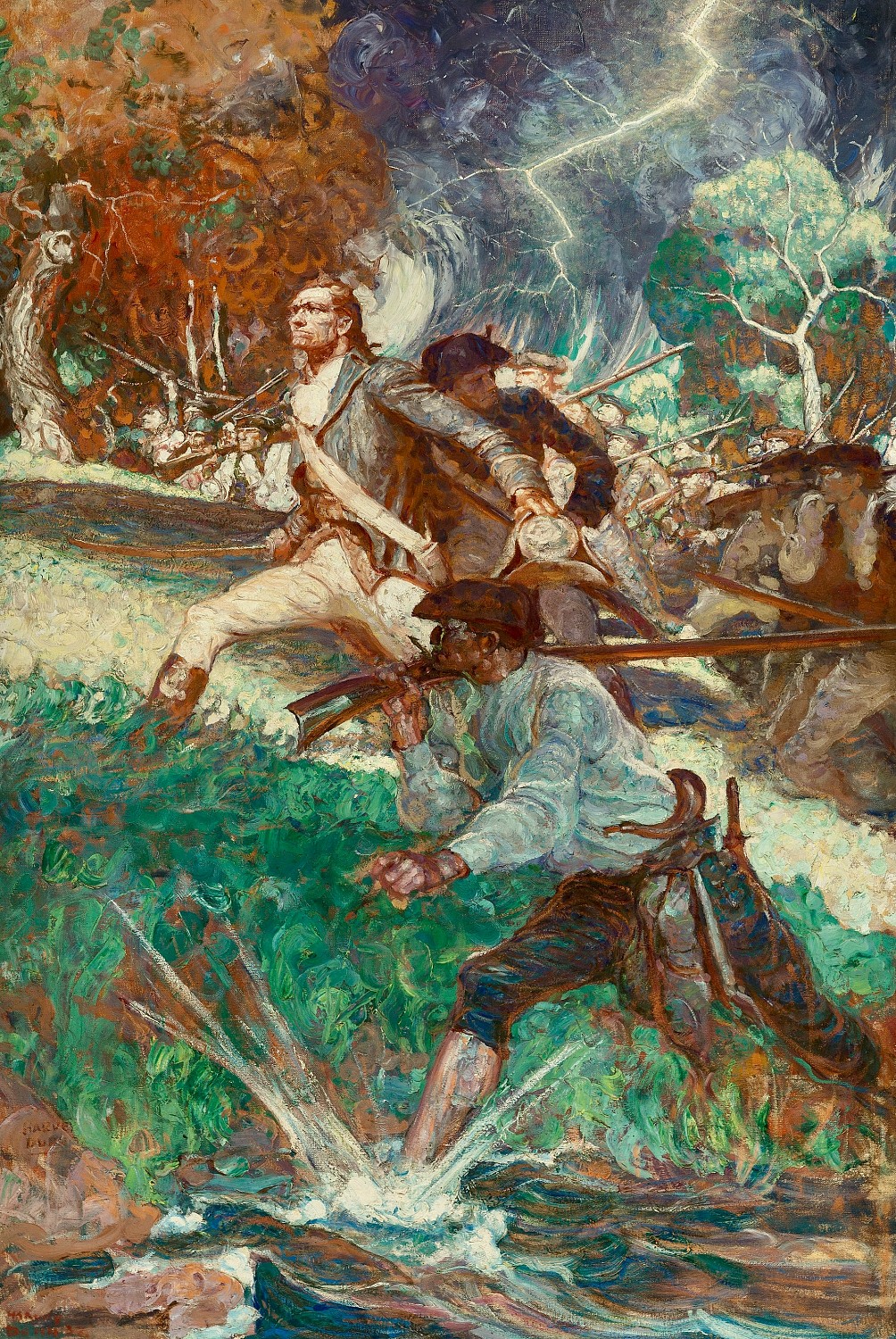"Dawn, Dawn, Dawn, Ticonderoga Pencil Advertisement" Lot no. 4134
By Harvey Dunn 1884-1952
1932 (Estimated)
60.00" x 40.00"
Oil on Canvas
Signed Twice and Dated Lower Left: Harvey / Dunn 1932
REQUEST PRICE
PURCHASE REQUEST
Harvey Dunn's Dawn, Dawn, Dawn is a truly exceptional illustration that captures a key moment of American History. In the present work, Dunn skillfully depicts colonial soldiers moving stealthily under the cover of night, rushing towards victory at Fort Ticonderoga with a surprise attack at dawn. The splashing water of the creek and the lengthening of strides of the soldiers perfectly encapsulates the rushed sense that this is the singular moment- lightning striking only once - for the Colonials to prevent defeat.
The Battle of Ticonderoga was the first battle in the American Revolution that the ragged and varied Colonials won. It was a decisive victory carried out by Ethan Allen and Benedict Arnold. Built at a narrows near the south end of Lake Champlain in northern New York State, Fort Ticonderoga's key location was the barrier of the North and West portions of the United States. By taking the fort, the Colonials would effectively prevent the British from flanking their forces and coming up behind General Washington's army. Additionally, the Colonials utilized over fifty cannons and military supplies taken from the fort to relieve the siege of Boston and therefore, this attack would lead to a key second win for the revolutionaries. The importance of these first few victories was vital to continued American defiance and morale - this particular triumph would demonstrate that despite going against the best military in the world, the Americans could in fact win.
To illustrate this moment, Dixon Ticonderoga hired Dunn, a prominent office and art supplies maker. They could not have chosen a better artist for this action filled scene. Dunn trained under Howard Pyle at his Brandywine School. Similar to his mentor, Dunn is meticulous in composition and draftsmanship, as seen in Dawn, Dawn, Dawn. The arch created by the tree at far left, juxtaposed against the wave of coming rain and lightning, highlights the central fighter, while a swooping diagonal line against his feet creates interest as well as a feeling of an unsteady and rushed movement. However, where Pyle and Dunn vary is their approach to the canvas. According to a fellow artist, "He [Dunn] literally attacked a canvas and sometimes I thought he would impale the painting with his brush" (A.R. Mitchell, Harvey Thomas Dunn 1884-1952, Trinidad, Colorado, 2018, n.p.). Dunn's visceral approach to painting is clearly seen in his quick and confident brushwork. The thick impasto, anchored by rich brown tones, leads the eye of the viewer once again towards the central figure. These swirling touches lend the painting an almost regionalist feel, but more importantly they create a sense of immediacy-The viewer naturally feels the tunnel vision of adrenaline with details fading away by the edges.
Never before seen on the open market, Dawn, Dawn, Dawn is truly a masterpiece of illustration of the Golden Age in style, subject, and scale.
Explore related art collections: Advertisements / Action / $100,000 & Above / Military/Soldiers / Historical / Violence/Guns / Newly Researched / Patriotic/Political
See all original artwork by Harvey Dunn
ABOUT THE ARTIST
Harvey Dunn was a large, powerful man who paid for his art schooling by “sod-busting”, plowing under the thick, virgin, prairie grass for his home-steading neighbors of the Red Stone Valley of South Dakota.
From the Art Institute of Chicago, he was invited by Howard Pyle to study at Chadds Ford. Of all Pyle’s students, Dunn was most deeply imbued with his philosophy, and as a teacher passed it along together with his own ideas, his straight-forward honesty and intolerance of pretense. Among his students were Dean Cornwell, Harold Von Schmidt, Amos Sewell, Lee Gustavson, Mario Cooper, Saul Tepper, and numerous others.
Dunn’s pictures, like the man, were forceful, yet combined great sensitivity with brilliant use of color. During World War I, Dunn was commissioned a Captain as an official war artist with the A.E.F. His experiences under fire produced many striking documentary drawings and paintings, now part of the archives of the Smithsonian Institution.
From notes taken during one of his classroom criticisms, the following fittingly describes his credo:
“Art is a universal language, and it is so because it is the expression of the feelings of man. Any man can look at a true work of art and feel kin to it and with him who made it – for he has the same number of heartbeats a minute, comes into the world to face the same joys, sorrows, and anticipations, the same hopes and fears. A vastly different vision may arise in the consciousness at the mention of a word, but our feelings are the same. By this you may know that the Brotherhood of Man is.”*
*quoted from An Evening in the Classroom, 1934



